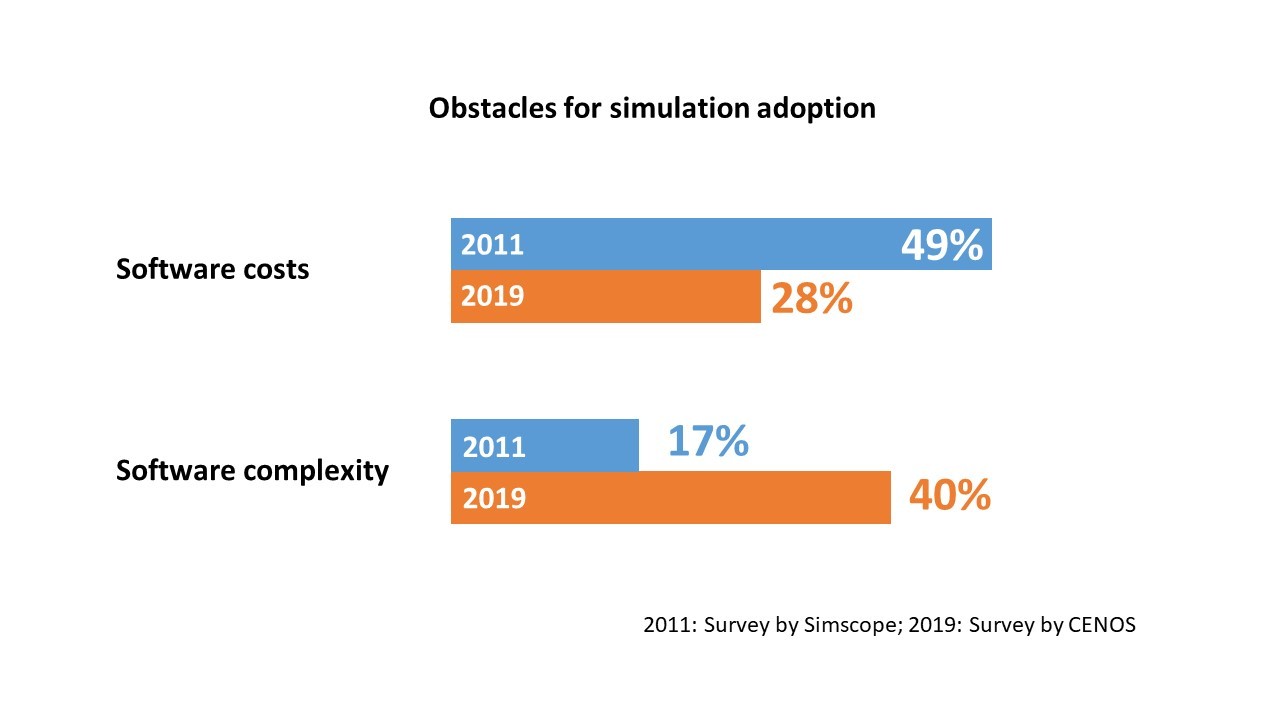Filling the gap in engineering simulation software market
Originally posted on LinkedIn
Increasing competition pushes engineering companies to advance the efficiency of design and engineering by means of digital transformation. Over the last decades, we have been observing the winning march of computer-aided design (CAD) programs, which are nowadays the market standard even for small workshops.
Now, it’s the time for software that covers the next step of engineering design workflow – computer-aided engineering (CAE) software (also known as simulation/modeling software).
Traditionally, enterprise-grade simulation software like ANSYS, SIMULIA, Altair Hyperworks is used by a relatively small group of highly experienced engineers in R&D centers of corporations. A couple of decades ago, that covered almost the whole addressable market. However, the demand in the SMB sector has been gradually growing and that was not recognized by the big players.
Besides overall advancement in the design process efficiency, simulation is frequently considered as an enabler for the adoption of additive manufacturing of parts and digital twin technologies, which ensured the recent jump of the demand for simulation. 40% of production engineers at plants and SMB suppliers say they want to use simulation but cannot [1].
I remember the story by Jack Harris (Chairman of IMS International) which was a colorful illustration of this software gap. In the keynote at Heat Treat show in Detroit in October 2019, he gave an example:
Boeing tried to push down SIMULIA software adoption in its supply chain. In return, it harmed the suppliers and entire supply chain since the software was an expensive investment for many SMBs and they were not even able to use the software properly due to lack of trained staff.
Let’s take a look at how the demand for simulation democratization looks like, and what the CAE-software market offers!
Demand for simulation democratization
In 2011, Simscape did the survey [2], which highlighted the software price as a major factor that holds back from simulation adoption at SMBs (49%), software complexity follows with 17%. In 2019, the survey by CENOS [3] shows the dominance of the same two answers, but the priority swapped: 28% of respondents highlighted the price point and 40% mentioned the software complexity (together with the similar answers like long learning period and lack of simulation engineers).
This probably indicates the progress in democratization and shift of the focus from pricepoint to the usability of the engineering tool to be utilized without special education, outside R&D centers – in production plants and by engineers at SMB suppliers. It is also nice to see the portals like revolutioninsimulation.org that highlights the demand for simulation democratization.

Let’s check now, what was the offering from the software companies to address the issue.
Cost-saving
As price point was indicated as the most painful aspect for simulation adoption in smaller companies, the software costs of ANSYS, Dassault Systems, Altair, and some other major market players were under the primary attack of newcomers. So did Comsol, with its multiphysics platform – the program, which ensures interconnectivity between mechanical, fluid,
electromagnetic, and other models. The name of the product – Comsol Multiphysics, highlights the main focus of the software, that was uptaken by academic customers first. Industrial customers appeared mostly at price-sensitive mid-size companies, which used the opportunity to buy separate modules at a lower price than from traditional enterprise-grade competition. Therefore, it seems that Comsol’s mainly emphasized benefit of multiphysics has never been accepted by the target market and didn’t lead to a real democratization of simulation. That is because multiphysics is not something SMBs need, quite the opposite – they need an easy to use tool which is specialized for their specific application.
Pay-as-go model
Although Comsol’s attempt was good enough to get some market share, at the end of the day it just demonstrated the potential of the academic community to alter traditionally expensive enterprise sales processes of the market leaders.
The real attempt of liberalization of the traditional pricing policy came from the software world. The simulation software companies were pushed to leave the traditional software purchase model, which requires a significant upfront investment, and offer a SaaS business model (they call it “software lease”) as an alternative. Furthermore, with the development of cloud computing services, they were pushed even further – to the pay-as-go model.
Initially, that sounded great, and the new model was uptaken by enterprise customers as costs- and cash flow optimization option but has not ended up with revolutionary democratization of simulation, just because the software itself remained to be a very heavy simulation tool designed for use of a privileged group of simulation engineers in R&D centers of enterprises.
Cloud computing services
The first real cloud computing service came from VC-backed SimScale – a Munich-based startup, which armed itself with the pay-as-go model and declared something really revolutionary – simulation in a browser. The newcomer identified hardware limitation as an obstacle for SMBs to adopt simulation practice. Indeed, in the computational fluid dynamics (CFD) domain – the sector SimScale was focused on, a high-performance computer (HPC) is a must to get simulation results in a reasonable time. Obviously, the HPC requirement is a real obstacle for the majority of potential simulation users – SimScale’s cloud-based simulation product became an enabling tool to democratize simulation in CFD. Excellent job, SimScale!
Nevertheless, the hardware issue is non-existent, except edge cases, outside the CFD domain. In heat transfer, electromagnetics, and structural mechanics, the majority of simulation tasks can be successfully performed on just a powerful PC. Therefore, the advantage of cloud-based simulation in a browser in these domains is not so high to overcome the friction towards cloud computing due to restrictive security policy regards to engineering data. Such friction seems to be natural for many SMB suppliers bent by strict NDAs with OEMs.
Thus, except for CFD, SimScale’s solution doesn’t seem to be a real driver for simulation democratization. The main problem remains unsolved – simulation is still too complicated for its mass adoption. This is why the cloud-based followers of SimScale (companies like OnScale) have focused their business strategies to the enterprise segment – to compete with traditional on-premises software like ANSYS or SIMULIA.
Appification
It seems now that the real mover of simulation democratization should solve the software complexity problem. Simplification of naturally complex things costs a lot and leads to a very narrow focus of the solution. Therefore, good niche products focus their business models on the enterprise segments to justify the development costs and the narrow market they operate at.
The nice effort to “appify” simulation models in a scalable way was undertaken by EASA software. They offer to create custom Excel-level web-apps as a simplification layer on top of complex simulation tools. Smart idea, but again – for enterprise customers.
Finally, the idea of the smart “appification” framework was recently proposed by European startup CENOS, the company that I have co-founded. CENOS claims its platform solution is able to create multiple industry-focused products in a scalable way to avoid the cost trap of enterprise-focused niche products.
The platform technology also claims to solve the second issue of simulation democratization – software cost. The company’s name was created as the acronym of “Connecting ENgineering Open Source” that demonstrates the way our company attacks the cost issue. Overall, we believe that community-driven open-source tools like FreeCAD, Salome, Gmesh, OpenFOAM, Paraview, and many others are underrated as potential democratization drivers.
It’s clear now that while the demand for simulation democratization has been increasing over the last decade to enable simulation-driven design for SMBs, the traditional companies – market leaders, haven’t been able to find a solution for this gap. Therefore, some new players have appeared and are looking for a proper solution to serve the rising SMB segment of the market. The newcomers bet on different drivers to democratize simulation, like the pay-as-go model, cloud computing, and “appification”. While it is clear already that the market in general and the SMB segment is growing fast enough to allow all of them to find their market share, we’ll see in the new decade, which approach will end up with the biggest exposure in the market.
References
[2] What is the biggest barrier to CFD adoption? Simscape, 05/2011
[3] Engineering simulations – key for SMEs to unlock Industry 4.0, CENOS, 02/2020


